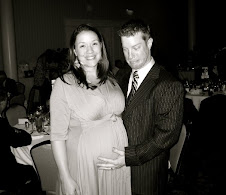
How your baby's growing:
Your baby is still packing on the pounds My brother came over last night and said, "Whoa, you're HUGE. That's not what you looked like 2 weeks ago!" — at the rate of about an ounce a day. She now weighs almost 6 pounds (like a crenshaw melon 3 weeks of melons? CHEATING.) and is more than 18 1/2 inches long. She's shedding most of the downy covering of hair that covered her body as well as the vernix caseosa, the waxy substance that covered and protected her skin during her nine-month amniotic bath. Your baby swallows both of these substances, along with other secretions, resulting in a blackish mixture, called meconium, will form the contents of her first bowel movement One of my hopes is that baby had control and doesn't let the meconium go until after he/she comes out. If they poo inside of you then they won't put the baby on your chest when it comes out. Not a HUGE biggie but just a private hope of mine.
At the end of this week, your baby will be considered full-term. YIPEE!(Full-term is 37 to 42 weeks; babies born before 37 weeks are pre-term and those born after 42 are post-term.) Most likely she's in a head-down position. Yes, they said they're pretty sure the baby is in head down but definitely not in the pelvis yet. But if she isn't, your practitioner may suggest scheduling an "external cephalic version," which is a fancy way of saying she'll try to coax your baby into a head-down position by manipulating her from the outside of your belly. How nicely put! What they do is they twist and turn your belly, forcing the baby to move in to the head down position. It's not fun for the Mom and doesn't work really well.
How your life's changing:
Now that your baby is taking up so much room, you may have trouble eating a normal-size meal. Yes, it's sad. Smaller, more frequent meals are often easier to handle at this point. Yes, for example, snacks are good. Like the cookie I just ate for the baby. On the other hand, you may have less heartburn and have an easier time breathing when your baby starts to "drop" down into your pelvis. Per the doctor this hasn't happened yet. Which surprises me after I just spent 4 days on my feet cleaning the house. This process — called lightening — often happens a few weeks before labor if this is your first baby. (If you've given birth before, it probably won't happen before labor starts.) If your baby drops, you may also feel increased pressure in your lower abdomen, which may make walking increasingly uncomfortable, and you'll probably find that you have to pee even more frequently. I find it very hard to believe that I'll have to pee even more. As it is I pee about once every 30 minutes or more. My trips to the bathroom have increased a lot over the last month but I guess that's just from the pure weight of the child, not "lightening". If your baby is very low, you may feel lots of vaginal pressure and discomfort as well. Some women say it feels as though they're carrying a bowling ball between their legs! No, I still feel like I'm carrying my bowling ball on my lower back.
You might also notice that your Braxton Hicks contractions are more frequent now. Yesssssss!!!!Be sure to review the signs of labor with your practitioner and find out when she wants to hear from you. She said don't call me until it hurts. I'm going to stick with my Braxton Hicks article a few posts back that says, "Plan to go to the hospital when they are so strong that you cannot hold a conversation during one" by the way, did you see that the author of that article wrote to me in the comments section? Pretty neat, eh?As a general rule, if you're full-term, your pregnancy is uncomplicated, and your water hasn't broken, she'll probably have you wait to come in until you've been having contractions that last for about a minute each, coming every five minutes for an hour. Of course, you'll want to call right away if you notice a decrease in your baby's activity or think you're leaking amniotic fluid, or if you have any vaginal bleeding, fever, a severe or persistent headache, constant abdominal pain, or vision changes.
Even if you're enjoying an uncomplicated pregnancy, it's best to avoid flying (or any travel far from home) during your final month because you can go into labor at any time. In fact, some airlines won't let women on board who are due to deliver within 30 days of the flight. I'm going to my Mom and Dads this weekend and they live an hour and 15 minutes away. Technically, that's farther than I'm supposed to go but my Dad is prepared to deliver the baby in the back yard. He's warming towels, sheets and boiling water in preparation.
Surprising Facts: The stages of labor
For first-time moms, labor takes an average of 15 hours shhhhhhhhhhhh, though it's not uncommon to last more than 20 seriously, shhhhhhhh. (For women who've previously had a vaginal birth, it takes eight hours, on average.) The process of labor and birth is divided into three main stages. Here are the highlights on how childbirth progresses:
First stage
The first stage begins when you start having contractions that progressively dilate and efface your cervix and it ends when your cervix is fully dilated. This stage is divided into two phases, early and active labor.
It can be tricky to determine exactly when early labor starts. That's because early labor contractions are sometimes hard to distinguish from the inefficient Braxton Hicks contractions that you may have been feeling for some time.
Unless there are complications or your midwife or doctor has advised you otherwise, expect to sit out most of your early labor at home. This is my plan! I think I'd rather be at home with Eric, my TV, my hot tub, my Internet and the nursery for as long as I can. Sure beats sitting in the hospital! (Be sure, though, to check in with your caregiver to make certain.)
Early labor ends when your cervix is about 4 centimeters dilated and your progress starts to speed up. At this point, you enter what's known as the active phase of labor. Your contractions become more frequent, longer, and stronger. This is around the time they offer up epidurals. My personal goal is to wait until 6 cm before the epidural. I'd like to be able to walk around (i.e. encourage the baby to come way down in the birth canal) before I get stuck in the bed. I have no idea if I can do it since you can't really train for this type of thing but it's my goal.
The last part of the active phase — when your cervix dilates from 8 to 10 centimeters — is called the transition period because it marks the transition to the second stage of labor. This is also when it's too late for an epidural. I was told they'd give it to you if you ask for it but that the chances of missing the pain relief altogether are extremely high at this point. This is the most intense part of the first stage, with contractions that are usually very strong, coming about every two and a half to three minutes and lasting a minute or more.
Second stage
Once your cervix is fully dilated, the second stage of labor begins: the final descent and birth of your baby. This is the "pushing" stage of labor, and it can last anywhere from minutes to a few hours. (It's likely to be quicker if you've previously given birth vaginally.) Again, I wish I could train for this! I want to be a good pusher. I know first time Moms are usually not considered "good pushers" and I'll just feel bad if I am told that my pushing isn't up to par.
Your baby's head will continue to advance with each push until it "crowns" — the term used to describe the time when the widest part of your baby's head is finally visible. After your baby's head comes out, your midwife or doctor will suction his mouth and nose, and feel around his neck for the umbilical cord. His head then turns to the side as his shoulders rotate inside the pelvis to get into position for their exit. With the next contraction, you'll be coached to push as his shoulders deliver, one at a time, followed by the rest of his body. Yay! This is when we find out if it's a boy or a girl!!!
You may feel a wide range of emotions now: euphoria, awe, pride, disbelief, excitement (to name a few), and, of course, intense relief that it's all over. Exhausted as you may be, you'll also probably feel a burst of energy, and any thoughts of sleep will vanish for the time being.
Stage three
The final stage of labor begins immediately after the birth of your baby and ends with the delivery of your placenta. The contractions in the third stage are relatively mild. I think it's dumb that they consider this a stage. Once I have my hands on the little devil I don't think there should be anymore stages. Who cares at that point?
This Week's Activity:
Create a grapevine. Make a list of all the people you want to hear about your baby's birth — with their phone numbers or e-mail addresses — and pass this along to a friend who can spread the news. DONE! That way, when you're ready for others to know, all you have to do is make one call. Include at least one person from work on the list, so they can spread the word there.












































